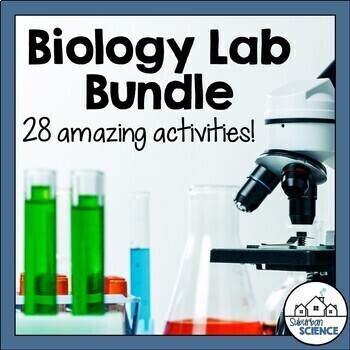High School Biology Lab Experiments - Biology Lab Activity Bundle
- Zip
- Easel Activity
What educators are saying
Products in this Bundle (28)
showing 1-5 of 28 products
Description
Need some ideas for fun Biology lab experiments and activities to revitalize your classroom? Never taught a high school Biology course and don't know where to start? These fun and easy labs are the perfect solution!
Topics covered include: characteristics of living things, macromolecules, enzymes, cells, osmosis, photosynthesis and cellular respiration, DNA, protein synthesis, biotechnology, natural selection, evolution, ecology, and human impacts on the environment.
Save yourself TONS of time and also save 20% instead of purchasing the labs individually!
Please note: All of these labs are also included in my Full-Year Biology Curriculum.
Each lab or activity includes teacher directions, a materials list, student procedures, discussion questions, and an answer key.
These labs are thorough, well-planned, and have been implemented many times in my own classroom. I've used these activities with both public school classes and homeschool co-op classes because they cover all of the essential biology topics and use inexpensive materials.
Included Labs & Topics:
- Intro to Biology Stations- graphing, fields of biology, microscope, etc.
- Measurement Stations- metric system, lab equipment, unit conversions
- Characteristics of Life- 7 characteristics shared by all living things
- Organic Macromolecules- carbohydrates, amino acids, protein folding
- Potato Catalase- enzyme function and specificity, denaturation
- Introductory Microscope Lab- microscope parts, plant & animal cell structures
- Organelle Dice- cellular organelle structures & functions
- Cell Membrane Model- lipid bilayer, phospholipids, channel proteins
- Egg Osmosis Lab- semipermeable membranes, tonicity and concentration
- Cell Size with Beets- cell division, diffusion, surface area to volume ratio
- Bromothymol Blue Lab- photosynthesis & cellular respiration
- Barf Bag Lab- fermentation, cellular respiration
- Leaf Chromatography- pigments, chlorophyll, photosynthesis
- Candy DNA Replication- semi-conservative replication, DNA structure
- Extracting DNA- histones, location of DNA, cell structure
- Protein Synthesis Activity- transcription, translation, anticodons, amino acids (with optional Thanksgiving activity)
- Build an Alien- genotypes, phenotypes, complete & incomplete dominance
- Human Karyotypes- trisomy, nondisjunction, chromosomal mutations
- Biotechnology- epigenetics, genetic engineering, CRISPR-Cas9, cloning
- Antibiotic Resistance- natural selection, population genetics, mutation
- Evidence for Evolution Stations- homologous structure, analogous structures, embryology
- Plant Cladograms- evolution, common ancestry, plant anatomy & physiology
- Radioactive Dating- half-life, fossils, extinction
- Dichotomous Key- traits, classification, taxonomy
- Greenhouse Effect- greenhouse gases, carbon cycle
- Carbon Cycle Game- cycling of matter, reservoirs & sinks, human impact
- Symbiosis Stations- mutualism, commensalism, parasitism
- Sustainable House Model- biodiversity, sustainability, human impacts
*Click on the PREVIEW of each resource to get a closer look at each lab.*
________________________________________________________________________
⭐For updates about sales and new products, please follow my store: My TpT Store
You can also
⭐Subscribe to my newsletter for freebies and teaching tips
⭐Follow me on Instagram
⭐Check out my Facebook page
⭐Follow me on Pinterest
I value your feedback. Please rate this product. If you have any issues or questions about this product, please feel free to ask a question in my store or write to me at support@suburbanscience.com.





